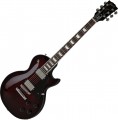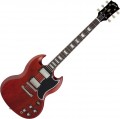Coil cutoff
The ability
to disable one of the coils in a humbucking pickup.
Pickups with this feature are, in fact, universal modules that can operate in both humbucking and single-coil modes. See "Pickup Diagram" for details on both. And the ability to switch between these modes allows the musician to change the colour of the sound without resorting to external gadgets or changing instruments. For example, for a dynamic composition with rich overdrive, it is more convenient to use a classic humbucker, and for a slow, lyrical melody, just move the switch and you can enjoy all the advantages of a single-coil.
Shape
The general shape of the body of an electric guitar.
The solid body of an electric guitar can be molded into almost any shape; hollow cases do not give such freedom, however, even among them, the options in shape can be very diverse. However, there are certain standard forms. It is not uncommon for these shapes to be named after a particular "legendary" guitar model, such as the "Les Paul" or "Stratocaster" (after Gibson and Fender instruments of the same name, respectively). It makes no sense to describe each standard form — it's easier to find an illustration in our catalog or on the Internet.
The main, and often the only point, which is affected by the shape of the body is the appearance of the guitar. Also, convenience for the musician to some extent depends on this parameter — for example, some models allow you to play while sitting, resting the instrument on your foot, for others this method is weak or not suitable at all. But whether the shape of the body affects the sound of an electric guitar is a moot point. There is an unequivocal dependence only in semi-acoustic models, but for solid bodies there is no clear answer to this question: some musicians claim the superiority of some forms over others, but this moment is largely subjective. In addition, other parameters (types and number of pickups, bridge design, etc.) greatly affect the sound quality.
Now on the market there are guitars with this body shape:
Les Paul,
Superstrat,
Stratocaster,
Jazz Bass,
Precision Bass,
Telecaster,
PRS Santana,
Flying V,
SG, however, there are also completely
non-standard options.
Cutaway
A type of cutout provided in the construction of a guitar body.
The notch is located at the point where the neck is attached to the body and can be
single or
double. The single cutout for a standard guitar hold is on the bottom, under the neck. It is designed to allow the player to comfortably use the higher (closer to the bridge) frets without the body getting in the way of the left hand (or right, in a left-handed instrument). In models with a double cutout, there is also a notch above the neck, it may be smaller than the bottom one. The top notch is provided mainly for aesthetic purposes, to give the instrument a distinctive appearance, but it can also be useful in fact — for example, if the player uses his thumb to hold the frets.
Note that some variants of the body shape do not provide cutouts at all — this is simply not required. Flying B body guitars are an example.
Body top
The material from which the soundboard cover is made is an additional overlay on the upper soundboard, which primarily plays a decorative role and gives the instrument a pleasant appearance. Do not confuse such a cover with a protective overlay (see above about it). And in semi-acoustic instruments with a hollow body (see "Type"), this paragraph may indicate the material of the upper soundboard, and a separate cover as such may be absent.
In general, the value of this parameter is similar to the material of the body (see above) — adjusted for the fact that the deck cover also directly determines the appearance of the electric guitar, and in semi-acoustic models it affects the sound more than the rest of the body. However, the main criterion for choosing this parameter may well be the aesthetic preferences of the musician.
Nut width
The width of the fretboard of an electric guitar at the nut. Closer to the body, the neck may expand somewhat, but this is not necessary, and the expansion angle may be different. Therefore, the main size is considered to be the width in the region of the nut.
This parameter has two meanings. On the one hand, a wide neck is inconvenient for musicians with small hands and short fingers — it can be difficult to reach the far strings in such cases. On the other hand, a larger width means a greater distance between the individual strings, which reduces the likelihood of hitting an adjacent string when pressed incorrectly and can make playing easier (especially if the guitarist has large fat fingers). However, these moments are not absolute, and the convenience of playing is a very subjective matter, depending on many features of the musician and the technique he uses. Also, don't forget that necks can have different profiles (see above), and instruments with different neck profiles will feel differently in the hands even with the same width at the nut. Therefore, the most reliable method of selection is to try out the necks of different sizes and profiles “live”, decide on the best option and choose based on this.
The smallest neck width at the nut in modern electric guitars is about 39 mm. This size is found mainly in bass guitars (see “Type”), which have 4 strings and a neck that widens noticeably towards the body (due to which it can be made rather narr...ow from above, especially since when playing bass, notes are rarely clamped near the neck itself) . Electric guitars (including semi-acoustic) are somewhat wider — from 41 mm, an indicator of 43 – 48 mm is considered average, and in the largest instruments, the neck can be up to 55 mm wide (however, such dimensions are typical mainly for instruments with more than 6 strings) .
Case
The presence of a
case or cover included with the guitar.
Both the case and the case are tool cases, with the difference that cases are made of hard materials and provide better impact protection, while soft cases are more convenient to transport (especially on the shoulders). Anyway, the case is highly desirable for storing and carrying the instrument. It at least protects the guitar from dirt, moisture, temperature extremes, shocks and other adverse effects, and when carrying it, it also provides additional convenience: the design has appropriate devices for this, such as handles or straps. In addition, cases and covers often have additional compartments for accessories (spare strings, picks, notebooks, pedals, etc.)
The presence of a case in the kit saves the musician from having to buy it separately — especially since such an accessory is optimally suited to the "native" model of the guitar. The latter is especially important for custom-shaped cases, for which it can be very difficult to find separately sold cases. At the same time, complete cases / covers may not provide the required degree of protection — often these are the simplest products, designed mainly for warm weather without precipitation. So the characteristics of the complete case will not hurt to clarify separately.

